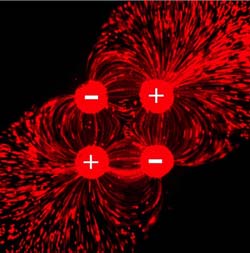Vacuum-like device makes cellular exploration easier

It’s a bit of a challenge. But, imagine a microscopic jet vacuum cleaner, the size of a pen nib that hovers over cell surfaces without ever touching them. Then imagine that the soap in the cleaning solution is replaced with various molecules that can be selectively delivered to the cells.
This gives you a sense of a new device that researchers believe will serve as a powerful tool to study the behaviour of living cells and a range of crucial cellular processes, from cancer cell formation to how neurons align themselves in the developing brain.
The device was developed by a team made up of Mohammad Ameen Qasaimeh and David Juncker from McGill’s Department of Biomedical Engineering, and Thomas Gervais from the Ecole Polytechnique of Montreal. It is based on using quadrupoles, or paired identical objects, two “positive” and two “negative” arranged in a square in order to create a force field between them. Electrostatic quadrupoles are used in radio antennae, and magnetic quadrupoles serve to focus beams of charged particles in particle accelerators. Quadrupoles also exist in fluids. They have been described theoretically for decades, but this is the first time that they’ve been fabricated in a lab setting.
The device is fabricated by etching four holes in a silicon tip, which is about 1 mm square. When the device is brought close to a surface, it acts on it pretty much like a water jet vacuum cleaner would. Two apertures (the “plus” holes, or sources) emit microscopic jets of fluid, onto the surface below and the two other apertures (the “minus” holes, or drains), immediately suck them back into the device.
In the vacuum cleaner analogy, if the carpet is replaced by a slice of living tissue, or a layer of adherent cells, the device can float over that surface to reach a desired target. It then simply sends out a stream of fluid with the chemicals needed to stimulate, probe, detach or kill the cells, depending on the application.
The device can also create regions of smoothly varying chemical concentration called gradients. These gradients are the key to studying many cellular processes such as how bacteria and other cells move about in the body. The researchers hope that this new kind of device will find many applications in the in vitro study of a wide range of essential cellular processes.
The research was funded by: CIHR, NSERC, FQRNT, CFI and CRC.
An article about the device was recently published in the journal Nature Communications. For an abstract: http://www.nature.com/ncomms/journal/v2/n9/full/ncomms1471.html
More news from McGill University: http://www.mcgill.ca/newsroom/
Media Contact
All latest news from the category: Life Sciences and Chemistry
Articles and reports from the Life Sciences and chemistry area deal with applied and basic research into modern biology, chemistry and human medicine.
Valuable information can be found on a range of life sciences fields including bacteriology, biochemistry, bionics, bioinformatics, biophysics, biotechnology, genetics, geobotany, human biology, marine biology, microbiology, molecular biology, cellular biology, zoology, bioinorganic chemistry, microchemistry and environmental chemistry.
Newest articles

Webb captures top of iconic horsehead nebula in unprecedented detail
NASA’s James Webb Space Telescope has captured the sharpest infrared images to date of a zoomed-in portion of one of the most distinctive objects in our skies, the Horsehead Nebula….

Cost-effective, high-capacity, and cyclable lithium-ion battery cathodes
Charge-recharge cycling of lithium-superrich iron oxide, a cost-effective and high-capacity cathode for new-generation lithium-ion batteries, can be greatly improved by doping with readily available mineral elements. The energy capacity and…

Novel genetic plant regeneration approach
…without the application of phytohormones. Researchers develop a novel plant regeneration approach by modulating the expression of genes that control plant cell differentiation. For ages now, plants have been the…





















